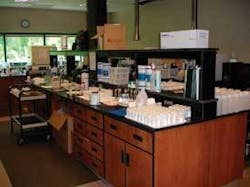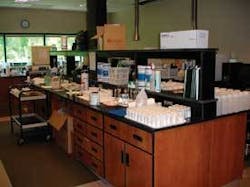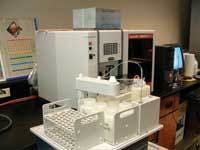by Alan Serrero, Ted Paczek and Christine Paszko
Many laboratories may have the expertise to translate manual processes and laboratory automation requirements into a detailed specification document for all of the system requirements, features and functions of a laboratory information management system (LIMS). However, that may not be the best use of their resources. In addition, this can be labor intensive and the laboratory personnel may be too close to the project and may not be objective or may not be familiar with some of the new tools and technologies available.
An expert Needs Assessment can provide a strong foundation for the successful implementation of a LIMS and can also save the laboratory significant resources. A professional assessment can provide the laboratory team with a comprehensive document that can be used to prioritize automation enhancements, provide automation recommendations and allow all internal and external (vendor) team members to have a common blueprint.
Case Study
The Gwinnett County Department of Public Utilities operates a central laboratory for analyzing water, wastewater, and environmental samples. The Gwinnett Water Resources Laboratory (WRL) staff includes analysts, field personnel (including the Industrial Pretreatment Program), management, and computer support for a total of 25 employees. The WRL processes approximately 20,000 samples and performs 57,000 analyses per year.
Prior to implementing an automated information management system, the laboratory used a manual method of managing laboratory information. Raw data was maintained in paper logbooks or entered into Microsoft Excel spreadsheets and reports were often generated in Microsoft Word. While this method was sufficient when the laboratory was smaller, as the laboratory grew managing information and trying to obtain trending data was proving to be increasingly time consuming, error prone and complex. Recording and extracting appropriate data for analysis and reporting was becoming difficult at best. To mitigate these issues the WRL set the following goals for a LIMS system:
- Improved sample tracking, organization, and analysis of sampling data and analytical data from both in-house and contract laboratories.
- Enhanced reporting, automation and control of data collections, sample scheduling, bar-coded label generation, laboratory functions, and procedures.
- Interfacing with laboratory equipment to make data collection easier and more accurate (decreasing transcription errors).
- Management and dissemination of all information generated in the WRL in accordance with regulatory requirements such as the EPA’s GALP (Good Automated Laboratory Practices), the Enhanced Security described in 21 CFR Part 11, and the requirements of National Environmental Laboratory Accreditation Program (NELAP).
- Interfacing the LIMS directly with other enterprise databases, allowing enhanced communication across the organization.
- Ability to view historical data (trending) as well as the ability to generate quality control charts.
These goals were incorporated into the issued RFP (Request for Proposal) for a LIMS. Given the laboratory’s experience with primarily manual processes and the inexperience with mapping these processes into a LIMS, the RFP requested that the vendor of the chosen LIMS system conduct an automation evaluation of the laboratory and configure the LIMS to the characteristics of the laboratory.
Needs Assessment/ Process Mapping
Accelerated Technology Laboratories (ATL) was the chosen vendor. The information system selected was the company’s Sample Master® Pro LIMS.
As part of the contract, the company defined and implemented a three step Needs Assessment Process:
The first step in the Needs Assessment was performed on-site at the WRL and provided a high level sample flow schematic. Activities associated with sample flow in the laboratory, from sample receipt through sample disposition and reporting, were observed and documented taking into account, process, time, instrumentation, materials and people. Visual observations, dialogue, check lists, and requests for example documents relating to the process being observed were requested and used during observation.
The next step in the assessment was a “cause and effect” analysis performed at ATL facilities. This analysis was performed by an experienced cross-functional ATL team based on the observations documented by the observer. The team included experience in laboratory operations, processes, and Sample Master® Pro LIMS implementation. During this analysis, as required, the WRL was contacted for clarification or additional detail.
Lastly, a comprehensive Needs Assessment Summary Report was generated, reviewed and provided to the WRL. This report included the observations gathered at the WRL, the analysis with respect to those observations and the resultant recommendations regarding automation opportunities with respect to laboratory processes and associated information flow (as they related to the implementation of the LIMS), and corresponding efficiency and data quality improvements.
Recommendations
The Needs Assessment recommendations provided by ATL streamlined the LIMS implementation and ensured that existing WRL processes were not only mapped into the LIMS, but also modified to ensure maximum efficiency gains. New processes were recommended and implemented for additional efficiency gains.
The following are just some examples of beneficial Needs Assessment recommendations that were implemented:
- The WRL field sampling process became more efficient with implementation of the Sample Master® Pro LIMS “Sample Scheduling” module. With this module, WRL can create projects for each type of field sample collection along with defined recurring schedules. Per the schedule defined by WRL, the LIMS provides notification that samples require collection. At the time of notification, WRL can print bar-coded labels for sampling containers along with COC (Chain of Custody) forms to be used in the field.
- Outsourced samples and analysis are tracked by the LIMS as to which outsource entity receives the samples. Analytical results are entered into the LIMS when they are received. Once results are entered and approved, the analytical data can easily be queried and reported.
- Rather than samples being delivered to various locations and to individual analysts, all samples are logged through a central receiving department. The receiving department sample flow is configured in the LIMS for better physical and workflow sample tracking and automated worklist creation. This ensures that analysts can determine when samples have arrived in a timely manner, without having to walk to a receiving area just to check.
- WRL now has the ability to easily track samples whether they are in a refrigerator, an incubator, or in disposal. As an increased efficiency example, the issue of incorrect sample carts being periodically removed from the main incubator before a required time period can be easily and inexpensively solved by printing a COC form in the LIMS and attaching the printed sheet to the bottles on the corresponding tray.
- A tedious manual process has now been eliminated as the results of sample analysis can be automatically compared in the LIMS to established parameters for each Gwinnett Count Department of Public Utilities facility and a visible indication is provided to the analyst whether the result meets the parameter or not (e.g. upon either manual data entry or instrument import, the result turning red would indicate a result out of spec).
- The LIMS interface to the operations software, OPS32TM, automatically transmits results between the two systems. This has eliminated the onerous and manual task of gathering, transcribing and re-transcribing results for input into the operations software package. It has also eliminated the associated transcription errors.
- Another area where transcription errors were eliminated (and where productivity was increased) was the integration of analytical instruments with the LIMS. This eliminated the previous manual entry of results into Excel spreadsheets. Instruments integrated included several Varian Atomic Absorption spectroscopy instruments, OI Analytical Autoanalyzer and a Shimadzu TOC analyzer. The instruments were selected and prioritized based on a strategic implementation plan recommended by the implementation team. The integration has made analytical results readily available for timely review and use.
Conclusion
A Needs Assessment is a good investment toward a successful Laboratory Information Management System deployment. The experience of subject matter experts in performing a Needs Assessment lays a strong foundation and a powerful road map to the implementation of a LIMS. Not only does it allow the laboratory LIMS team to focus their resources at those areas that will return the greatest value, but it allows the laboratory to fine tune their processes to optimize efficiency, productivity and ensure regulatory compliance. In order to maximize the benefit of the Needs Assessment, it should be done as early in the planning process as possible. This allows the laboratory to really examine what they want the LIMS to do, which features they want and what the scope of the total project will be. The assessment will also uncover any potential project implementation risks and prepare a strategy to address any obstacles that detract from a successful deployment.
The Gwinnett laboratory now enjoys increased control of their samples, data management, data access, analysis and meeting regulatory requirements. This represents a significant improvement over the previous islands of information that were located in separate logbooks and Excel spreadsheets. With the ability to set permissions, automatically e-mail pdf reports, and integrate with other applications, the LIMS offers a centralized data repository from which final analysis reports can be generated and data exchanged with others in the organization.
About the Author:
Alan Serrero is the Quality Systems Manager for the Water Resources Laboratory of the Gwinnett County Department of Public Utilities. Serrero was the lead manager for the LIMS selection and implementation at WRL. Ted Paczek is Director of Sales and Marketing and Dr. Christine Paszko is VP of Sales and Marketing at ATL.
The ATL observer’s role was to complete and document unbiased observations with special attention to the following:
Laboratory Sample Flow
- Sample login process
- Sample chain of custody form
- Worklist utilization
- Sample conditioning
- Sample scheduling
- Sample methods
- Sample tests
- Analysis
- Instrument analysis
- QA/QC
- Test results
- Result validation
- Result approval
- Reporting
- Sample disposal
- Time tracking
- Customer Relationship Management
- Materials including inventory
- Resource qualification and management (instruments and people)
- Regulatory compliance
Laboratory Employees
- Obtained functional organization chart
- Documented each employee’s responsibilities
- Documented perceived issues and requirements for each sample flow stage/process
- Documented any other perceived issues, risks or concerns
Client Expectations
- Each system user was interviewed and asked a few questions concerning their specific management needs regarding a LIMS implementation
Computer Hardware, Software, and Network
- Existing Client hardware and software were documented
- Existing Server hardware and software were documented
- Existing Network bandwidth, hardware, software and topology were documented






